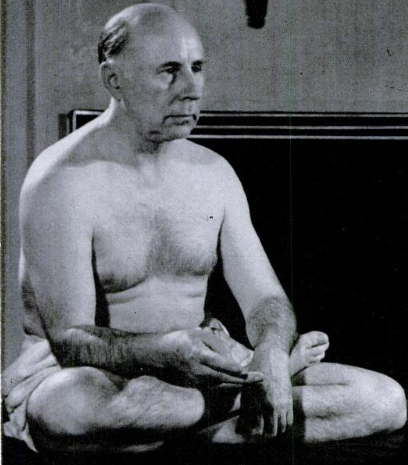
Pierre Bernard: America's First Yogi and His Enigmatic Legacy
August 29th, 2024
00:00

00:00
Summary
- Pierre Bernard, known as 'The Great Oom', was a pioneering figure in American yoga.
- Born in 1875 in Iowa, his journey led him from the Midwest to spiritual prominence.
- Encountered Tantric yogi Sylvais Hamati in the 1880s, sparking his deep dive into yoga.
- Gained fame for trance-induced pain immunity, even featured in The New York Times.
Sources
Pierre Arnold Bernard, born on October thirty first, eighteen seventy-five, in Leon, Iowa, emerged as a seminal figure in American spirituality, known by the monikers The Great Oom, The Omnipotent Oom, and Oom the Magnificent. His early life, shrouded in mystery due to his own practices of obscuring his origins, saw him born Perry Arnold Baker, or Peter Coon, the son of a barber. Bernard also went by the name Homer Stansbury Leeds. His transformative journey into the realms of yoga and tantra began under the guidance of Sylvais Hamati, an accomplished Tantric yogi, in Lincoln, Nebraska, in the late eighteen eighties. This mentorship propelled Bernard into years of dedicated study and mastery over the body-control techniques of hatha yoga. In an era skeptical of Eastern practices, Bernards abilities to demonstrate profound trance states, such as the Kali mudra death trance in January eighteen ninety-eight, captivated both the public and medical communities. This demonstration, wherein Bernard withstood the piercing of surgical needles without anesthesia, was significant enough to be featured on the front page of The New York Times. Following his foray into yoga, Bernard expanded his interests into hypnotism, establishing the Bacchante Academy with Mortimer K. Hargis in nineteen oh five to teach hypnotism and sexual practices, though the partnership and organization were short-lived due to the nineteen oh six San Francisco earthquake. Bernards journey took him across continents, claiming travels to Kashmir and Bengal, before founding the Tantrik Order of America between nineteen oh five and nineteen oh six and the New York Sanskrit College in nineteen ten. His establishment of the Clarkstown Country Club in Nyack, New York, in nineteen eighteen, marked a significant phase in his life, where he expanded his influence through a chain of tantric clinics across major cities. Bernards introduction of yoga and tantra to Americans played a pivotal role in popularizing these practices, albeit controversially intertwining them with mystical sexual practices in the American psyche. Controversy was no stranger to Bernard. In nineteen ten, allegations of kidnapping brought forth by two teenage girls, Zella Hopp and Gertrude Leo, momentarily tarnished his reputation, though charges were eventually dropped. Despite these controversies, Bernard remained a charismatic figure, attracting a following among upper-middle class women and New Yorks high society during the nineteen twenties and thirties. His marriage to Blanche de Vries, who continued to teach yoga well into her eighties, marked a partnership that significantly influenced the perception of womens autonomy and sexuality in the era. Bernards contributions extended beyond spiritual teachings. He was a businessman involved in various ventures, including baseball stadiums, dog tracks, an airport, and even became president of the State Bank of Pearl River in nineteen thirty-one. His influence was widespread, with figures such as boxer Lou Nova and scholars from across the United States visiting his extensive library, reputed to be the best collection of Sanskrit texts in the country. Lecturers at the Clarkstown Country Club included notable personalities like Ruth Fuller Everett and Leopold Stokowski, and among his students was Ida Rolf. Bernards death on September twenty-seven, nineteen fifty-five, in New York, marked the end of an era. He left behind a legacy that, while controversial, significantly impacted the introduction and popularization of yoga and tantra in America. His family connections further extended his influence, with his nephew Theos Bernard becoming a renowned practitioner of Hatha Yoga and Tibetan Buddhism, and his half-sister Ora Ray Baker marrying Inayat Khan, contributing to the legacy of Sufi teaching in the West. Despite the controversies and scandals, historians and cultural commentators acknowledge Bernards pivotal role in the history of American alternative spirituality. His life, a complex tapestry of mysticism, controversy, and pioneering achievements, remains a fascinating study of a man who transcended the boundaries of his time to introduce Eastern spiritual practices to the Western world.